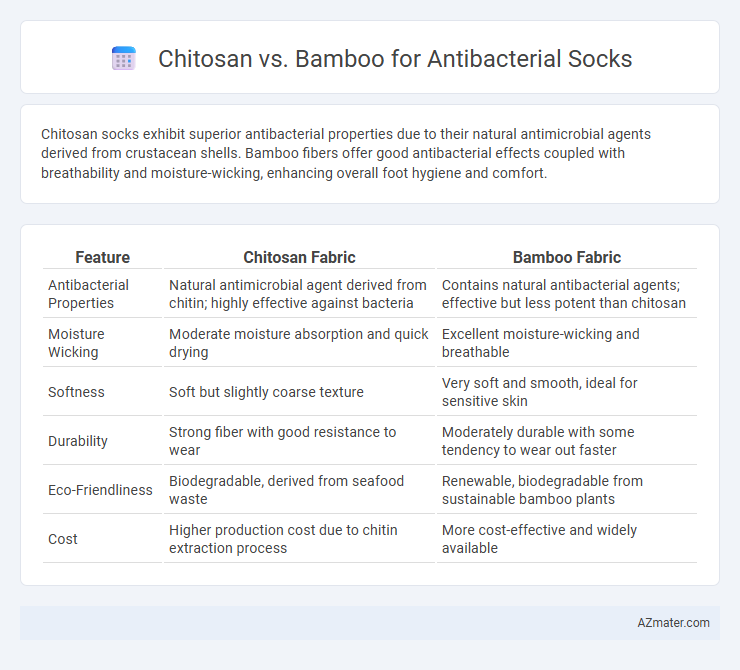Chitosan socks exhibit superior antibacterial properties due to their natural antimicrobial agents derived from crustacean shells. Bamboo fibers offer good antibacterial effects coupled with breathability and moisture-wicking, enhancing overall foot hygiene and comfort.
Table of Comparison
| Feature | Chitosan Fabric | Bamboo Fabric |
|---|---|---|
| Antibacterial Properties | Natural antimicrobial agent derived from chitin; highly effective against bacteria | Contains natural antibacterial agents; effective but less potent than chitosan |
| Moisture Wicking | Moderate moisture absorption and quick drying | Excellent moisture-wicking and breathable |
| Softness | Soft but slightly coarse texture | Very soft and smooth, ideal for sensitive skin |
| Durability | Strong fiber with good resistance to wear | Moderately durable with some tendency to wear out faster |
| Eco-Friendliness | Biodegradable, derived from seafood waste | Renewable, biodegradable from sustainable bamboo plants |
| Cost | Higher production cost due to chitin extraction process | More cost-effective and widely available |
Introduction to Antibacterial Socks
Antibacterial socks enhance foot hygiene by preventing odor and bacterial growth through the use of advanced materials like chitosan and bamboo fibers. Chitosan, derived from crustacean shells, offers natural antimicrobial properties that inhibit bacteria and fungi, while bamboo fibers provide breathability and moisture-wicking capabilities with inherent antibacterial effects. The comparison between chitosan and bamboo in antibacterial socks centers on their effectiveness in odor control, durability, and environmental sustainability, which are critical factors for consumer preferences and performance.
What is Chitosan?
Chitosan is a natural biopolymer derived from chitin, commonly found in the exoskeletons of crustaceans such as shrimp and crabs, known for its excellent antibacterial properties. This substance is widely used in antibacterial socks due to its ability to inhibit the growth of harmful bacteria, reduce odors, and promote foot health. Compared to bamboo, chitosan offers a more targeted antimicrobial effect, making it a superior choice for durable and hygienic sock materials.
What is Bamboo Fiber?
Bamboo fiber is a natural textile derived from the pulp of bamboo plants, valued for its softness, breathability, and moisture-wicking properties. Unlike chitosan, which is a biopolymer obtained from crustacean shells and known for its potent antibacterial effects, bamboo fiber contains natural antimicrobial agents such as bamboo kun that inhibit bacterial growth. This makes bamboo fiber an eco-friendly and sustainable choice for antibacterial socks, combining comfort with odor resistance.
Antibacterial Properties of Chitosan
Chitosan exhibits strong antibacterial properties due to its ability to disrupt microbial cell membranes, making it highly effective in inhibiting the growth of bacteria in socks. Its natural biopolymer structure allows for sustained antimicrobial activity, reducing odor and improving foot hygiene. Compared to bamboo, chitosan offers superior antibacterial efficacy, enhancing the overall performance of antibacterial socks.
Antibacterial Benefits of Bamboo Fiber
Bamboo fiber exhibits natural antibacterial properties due to the presence of bamboo kun, a bio-agent that inhibits the growth of bacteria, making it highly effective for odor control in socks. Studies show bamboo socks reduce microbial activity significantly, enhancing foot hygiene and preventing infections. Compared to chitosan, bamboo fiber offers a sustainable, biodegradable solution with intrinsic antibacterial benefits suitable for sensitive skin.
Performance: Chitosan vs Bamboo in Sock Fabric
Chitosan fibers in antibacterial socks exhibit superior antimicrobial efficacy due to their natural polycationic properties that disrupt bacterial cell walls, resulting in prolonged odor control and hygiene. Bamboo fabric, while inherently antimicrobial due to its natural bioagents like bamboo kun, offers moderate antibacterial performance but excels in moisture-wicking and breathability for comfort. Chitosan outperforms bamboo in sustained antibacterial activity, whereas bamboo provides better moisture management and softness, influencing the choice based on specific sock performance needs.
Comfort and Breathability Comparison
Chitosan-infused socks offer superior antibacterial properties while maintaining excellent moisture-wicking capabilities, enhancing overall comfort during extended wear. Bamboo fabric excels in breathability due to its natural porous structure, allowing for optimal airflow that keeps feet cool and dry. Both materials provide distinct advantages, with chitosan focusing on antimicrobial efficiency and bamboo prioritizing lightweight ventilation and softness.
Environmental Impact: Chitosan vs Bamboo
Chitosan, derived from crustacean shells, offers a biodegradable and renewable resource that reduces marine waste while supporting sustainable fisheries. Bamboo grows rapidly without pesticides, requiring minimal water and land, making it an eco-friendly choice for antibacterial socks. Both materials boast low environmental footprints, but bamboo's fast growth and carbon sequestration provide notable advantages in reducing ecological impact.
Durability and Longevity of Materials
Chitosan fibers exhibit superior antibacterial properties and biodegradability but tend to have lower mechanical strength and durability compared to bamboo fibers, which are known for their toughness and long-lasting wear resistance in sock applications. Bamboo fabric offers enhanced durability due to its natural cellulose structure, making it more resistant to frequent washing and daily abrasion. Comparative studies indicate bamboo socks maintain their integrity and antibacterial performance over extended use, whereas chitosan socks may degrade faster under similar conditions.
Choosing the Best Antibacterial Sock: Chitosan or Bamboo?
Chitosan-infused socks offer potent antibacterial properties derived from chitin in crustacean shells, effectively reducing odor-causing bacteria and promoting foot hygiene. Bamboo socks provide natural antibacterial benefits through bamboo fiber's inherent antimicrobial compounds, along with excellent moisture-wicking and softness for comfort. Choosing the best antibacterial sock depends on prioritizing either chitosan's strong antibacterial action or bamboo's eco-friendly, breathable, and naturally antimicrobial qualities.

Infographic: Chitosan vs Bamboo for Antibacterial Sock
 azmater.com
azmater.com